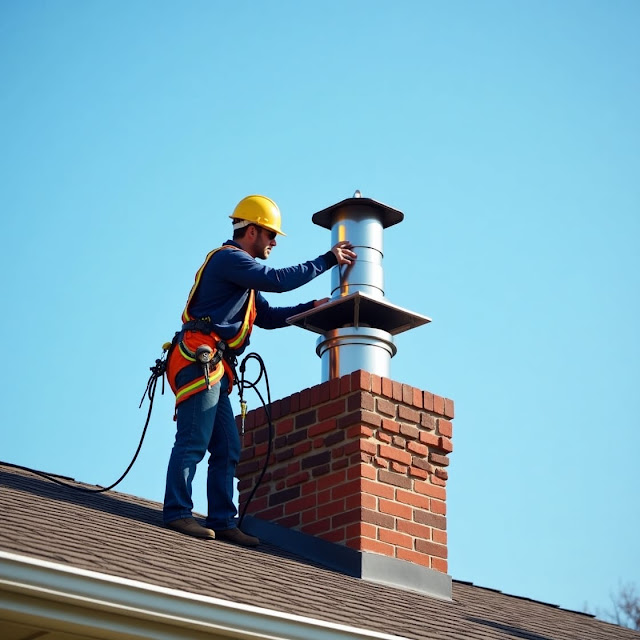A chimney cap might seem like a small addition to your home, but it plays a crucial role in maintaining your chimney’s safety and efficiency. Whether you're upgrading your chimney or installing a new one, choosing the right chimney cap is essential. In this guide, brought to you by Chimney Cap Installation, we’ll explain what chimney caps do, why they matter, how to choose the best one, and what materials are most effective for different home types.
What Is a Chimney Cap?
A chimney cap is a protective covering installed on the top of a chimney. It prevents rain, debris, animals, and even downdrafts from entering the flue. Without a proper chimney cap, your fireplace or heating system becomes vulnerable to water damage, blockages, and fire hazards.
At Chimney Cap Installation, we’ve seen firsthand how a missing or poorly fitted cap can lead to thousands of dollars in chimney repairs. That’s why selecting the right one is critical for your home’s longevity and safety.
Why Is a Chimney Cap Important?
Here are the top reasons why every chimney should have a cap:
- Weather Protection: Keeps rainwater out, preventing structural damage.
- Animal Prevention: Blocks squirrels, birds, raccoons, and other pests.
- Spark Arresting: Helps prevent roof fires caused by escaping embers.
- Downdraft Control: Reduces cold drafts and helps with proper ventilation.
- Debris Blocking: Keeps leaves and twigs from obstructing your flue.
“A chimney without a cap is like a house without a roof — exposed and vulnerable.”
How to Choose the Best Chimney Cap
There’s no one-size-fits-all approach. The best chimney cap depends on your chimney type, climate, and local wildlife concerns. Here are the main factors to consider when selecting a chimney cap:
1. Chimney Type
- Masonry Chimneys: Typically require larger, more robust caps.
- Prefabricated Chimneys: Need specific factory-made caps to match the system.
2. Material Type
- Stainless Steel: Durable, rust-resistant, and excellent for all climates.
- Copper: Aesthetic appeal with long-lasting durability, but more expensive.
- Galvanized Steel: Budget-friendly but prone to rust; suitable for low-humidity regions.
3. Mounting Style
- Single-Flue Caps: Fit snugly over one flue tile.
- Multi-Flue Caps: Cover multiple flues and can protect the entire crown.
- Top-Mount or Outside-Mount: Depends on whether the cap is secured over the flue or the chimney crown.
4. Features
- Screen Mesh Size: Keeps out animals without restricting airflow.
- Spark Arrestors: Essential in fire-prone areas.
- Rain Guards: Additional protection in high rainfall areas.
Comparison Table: Chimney Cap Materials
| Material | Durability | Rust Resistance | Cost | Ideal For |
|---|---|---|---|---|
| Stainless Steel | High | Excellent | Moderate | All climates, long-term use |
| Copper | Very High | Excellent | High | Premium homes, aesthetics |
| Galvanized Steel | Low | Poor | Low | Temporary use, dry environments |
| Aluminum | Moderate | Moderate | Low-Moderate | Coastal homes, rust protection |
Common Mistakes to Avoid
While choosing a chimney cap may seem straightforward, these common mistakes can lead to major issues:
- Wrong Size: A cap that’s too small or too big won’t seal or secure properly.
- Ignoring Material Compatibility: Certain caps don’t work well with acidic soot from wood-burning fireplaces.
- DIY Installation Without Proper Tools: Poor installations often lead to caps blowing off during storms.
- Skipping Local Code Checks: Some areas have specific venting or spark arrestor requirements.
That’s why it's best to work with professionals like Chimney Cap Installation, where we assess your chimney and recommend the perfect cap based on your structure and local regulations.
Professional vs. DIY Chimney Cap Installation
While some homeowners attempt to install chimney caps themselves, hiring a certified technician ensures safety, proper fit, and code compliance.
Professional Installation Benefits:
- Custom fit and weather-sealed
- Safety inspections included
- Warranty-backed services
- Faster and cleaner installation
At Chimney Cap Installation, we offer end-to-end services including inspection, installation, and repair. We use premium-grade materials that last for decades and ensure complete weather protection for your chimney.
Frequently Asked Questions (FAQs)
Q1: How do I know what size chimney cap I need?
A: Measure the outside dimensions of your flue or crown. Our team at Chimney Cap Installation can help with professional measurements to ensure the perfect fit.
Q2: Can a chimney cap improve my home’s energy efficiency?
A: Yes, it reduces downdrafts, keeping cold air out and warm air in during winter, improving HVAC efficiency.
Q3: How long does a chimney cap last?
A: Stainless steel and copper caps can last 20+ years, while galvanized steel may last 5–7 years in mild conditions.
Q4: Do chimney caps require maintenance?
A: Periodic inspections are recommended. At Chimney Cap Installation, we offer annual inspection services to keep your cap functioning optimally.
Q5: Is it possible to install a cap on an old or damaged chimney?
A: Yes, but the chimney may require repairs first. We can assess and recommend a plan tailored to your chimney’s condition.
Final Thoughts
Choosing the right chimney cap can make a significant difference in your home’s safety, efficiency, and longevity. From preventing animal invasions to avoiding water damage, a cap is a small investment with major returns.
If you're unsure about what kind of cap your home needs or you want expert installation, Chimney Cap Installation is your trusted local provider. We offer customized solutions, high-quality materials, and certified professionals to make sure your chimney stays protected all year long.
Read More : Chimney Animal Removal


0 Comments